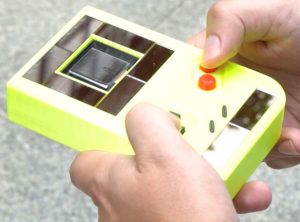
Northwestern University thinks so.
Working with Delft University of Technology, its researchers built something that looks, feels and works like an 8bit Nintendo Game Boy.
“It’s the first battery-free interactive device that harvests energy from user actions,” claimed Northwestern engineer Josiah Hester. “When you press a button, the device converts that energy into something that powers your gaming.”
What is in the buttons?
“The buttons generate power by moving a small but powerful magnet inside a tightly wound wire coil,” Hester told Electronics Weekly. “The change in the magnetic field generates power. When you press the button, and when you release it, it moves the magnet through the coil, this energy is then siphoned into a capacitor for immediate use by the hardware to support all activities. This is a straightforward application of Faraday’s law, but because of advances in manufacturing over the past decade, the magnet and coil are so small that they can fit inside a button that is acceptable to a user.”
The processor is not the original. Instead it is a proof-of-concept energy-aware gaming platform that the team has dubbed ‘Engage’ which impersonates a Game Boy processor.
“Although this solution requires a lot of computational power, and therefore energy, it allows any popular retro game to be played straight from its original cartridge,” according to Northwestern, which also said that the hardware and software have been designed to be energy aware and energy efficient.
Power glitches do occur, so system state is stored in non-volatile memory. “This eliminates the need to press ‘save’ as seen in traditional platforms, as the player can now continue gameplay from the exact point of the device fully losing power – even if Mario is in mid-jump,” said the university. “On a not-too-cloudy day, and for games that require at least moderate amounts of clicking, gameplay interruptions typically last less than one second for every 10 seconds of gameplay. The researchers find this to be a playable scenario for some games -including Chess, Solitaire and Tetris – but certainly not yet for all games.”
Part of the motivation for the fun-themed demo is to draw attention to the waste associated with many IoT devices.
“Our work is the antithesis of the Internet of Things, which has many devices with batteries in them,” Hester said. “Those batteries eventually end up in the garbage. If they aren’t fully discharged, they can become hazardous. They are hard to recycle. We want to build devices that are more sustainable and can last for decades.”
“With our platform, we want to make a statement that it is possible to make a sustainable gaming system that brings fun and joy to the user,” added TU Delft’s Przemyslaw Pawelczak.
The project is to be presented at ubiquitous and pervasive computing conference UbiComp 2020 on 15 September. (10:30am, Track A, IMWUT papers). The presentation will become available though this link
